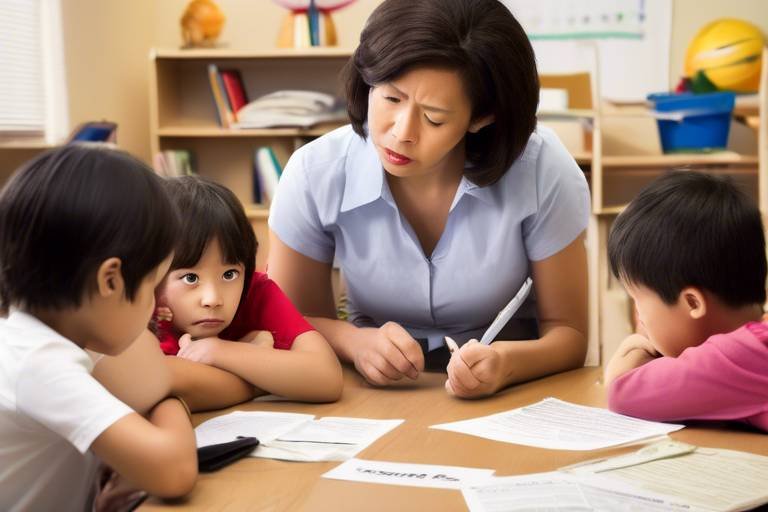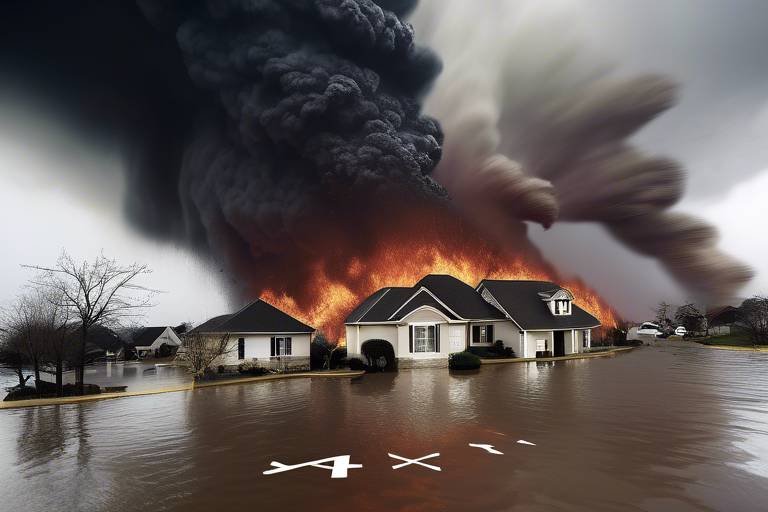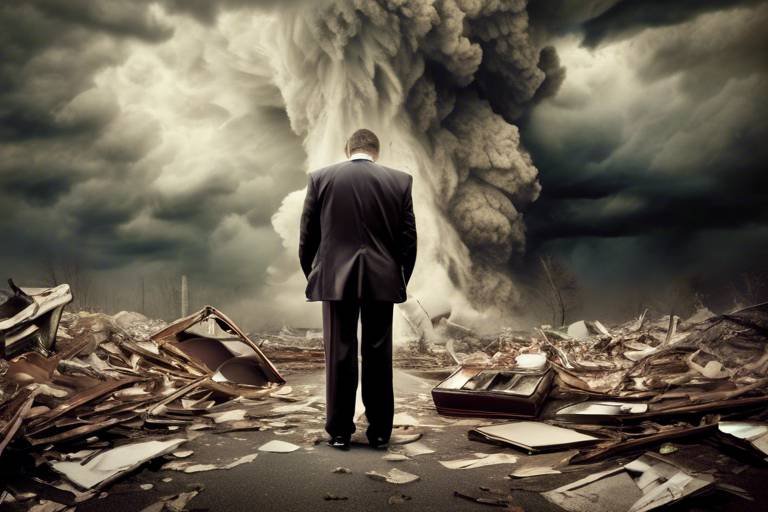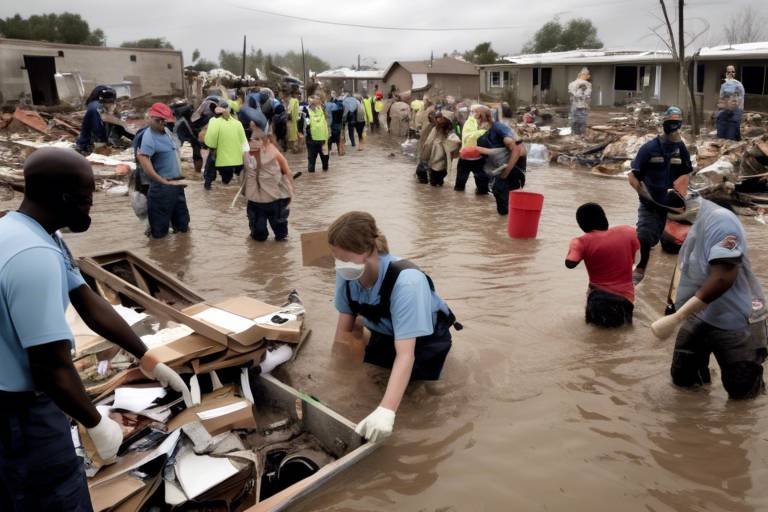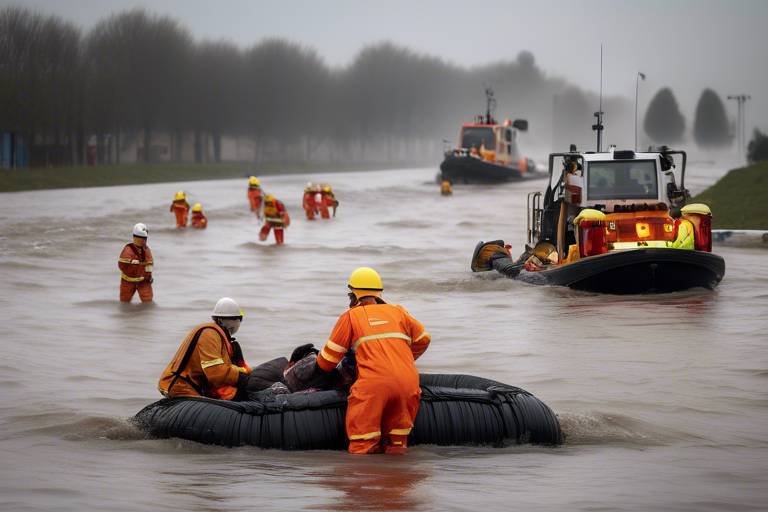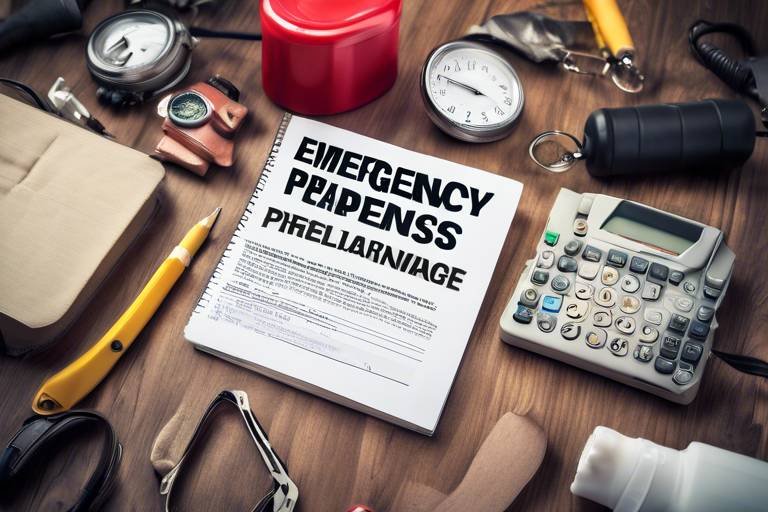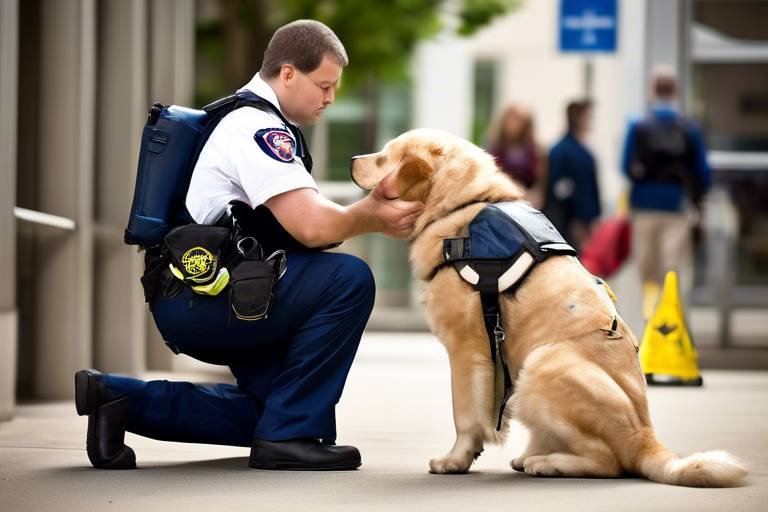The Roles of Parents and Teachers in Kids' Disaster Preparedness
In a world where unexpected disasters can strike at any moment, the significance of disaster preparedness cannot be overstated. It’s not just about having a first aid kit or knowing how to dial emergency services; it's about creating a culture of safety and awareness among our children. Parents and teachers, the two pillars of a child's support system, play distinct yet complementary roles in ensuring that kids are equipped to handle emergencies. By working together, they can create a comprehensive framework that fosters resilience, knowledge, and practical skills in children.
Imagine a scenario where a child knows exactly what to do during a natural disaster, not because they were scared into compliance, but because they were educated and engaged in the process. This is the goal of disaster preparedness education. It’s about empowering children with the confidence to act decisively and calmly in the face of chaos. Parents and teachers must collaborate to instill this confidence, turning fear into a sense of control.
In this article, we will explore the crucial roles of parents and teachers in disaster preparedness, emphasizing the importance of education, communication, and practical training. By understanding their unique responsibilities and working together, they can create a safe environment that not only protects children but also teaches them valuable life skills. Let’s dive deeper into the essentials of disaster preparedness and how these two groups can effectively prepare our future generations for the unexpected.
Disaster preparedness is more than just a buzzword; it's a vital skill set that every child should possess. It involves equipping children with the knowledge and skills necessary to respond effectively during emergencies. This includes understanding different types of disasters, recognizing warning signs, and knowing how to stay safe. To make this concept more relatable, think of disaster preparedness as teaching kids how to ride a bike. Just as they need to learn balance, control, and safety rules before hitting the road, they must also learn how to navigate emergencies.
Essential components of disaster preparedness for children include:
- Awareness: Understanding the types of disasters that can occur in their area, such as earthquakes, floods, or fires.
- Safety Measures: Learning about safety protocols, like where to go during an earthquake or how to stop, drop, and roll in case of a fire.
- Practice: Regularly participating in drills and simulations to reinforce their knowledge and skills.
By focusing on these key areas, parents and teachers can ensure that children are not only aware of potential dangers but are also prepared to respond effectively. This proactive approach can make all the difference when it comes to keeping kids safe during emergencies.
Parents serve as the first line of defense in disaster preparedness. They have the unique opportunity to create a safe and supportive environment at home, where discussions about safety can happen naturally. One of the most critical steps parents can take is to educate their children about potential disasters. This can include sharing stories, watching educational videos, or even visiting local emergency services to see how professionals respond to crises.
Moreover, parents should work on developing a family emergency plan. This plan should outline:
- Emergency contacts
- Evacuation routes
- Meeting points
- Safety supplies and their locations
Involving children in this planning process not only makes them feel included but also helps them understand their roles during a disaster. When children know what to expect and what is expected of them, they are more likely to remain calm and collected in an emergency.
Teachers play an instrumental role in disaster preparedness through structured educational programs. Schools are not just places for academic learning; they are also environments where children can learn essential life skills. By integrating disaster preparedness into the curriculum, teachers can ensure that students receive consistent and comprehensive education on this vital topic.
For instance, teachers can conduct drills that simulate various emergency scenarios, allowing students to practice their responses in a safe environment. These drills can include:
- Fire drills
- Earthquake drills
- Lockdown drills
Through these practical exercises, students learn to react quickly and effectively, reducing panic and confusion during real emergencies. Teachers can also facilitate discussions about safety procedures, helping students to voice their concerns and ask questions. This open line of communication fosters an environment of trust and preparedness.
Creating an effective emergency plan is vital for both families and schools. A well-thought-out plan can make a significant difference in how individuals respond during a disaster. Parents and teachers should collaborate to develop comprehensive emergency plans that involve children in the planning process. This not only educates them about the plan but also empowers them to take an active role in their safety.
Effective communication is essential during a disaster. Parents and teachers need to establish clear communication strategies that convey risks, safety procedures, and the importance of remaining calm. Using simple language, visuals, and role-playing can help make these concepts more relatable and easier for children to grasp.
Engaging children in hands-on preparedness activities is one of the most effective ways to foster learning and retention. When kids are actively involved, they are more likely to remember what they’ve learned. Parents and teachers can implement various activities, such as simulations, workshops, and even games, to make preparedness fun and educational.
Resilience is key to coping with disasters. Parents and teachers can help children develop emotional resilience by teaching them coping strategies and instilling confidence in their ability to handle emergencies. This can include practicing mindfulness techniques, encouraging positive self-talk, and providing support during challenging situations.
Finally, community involvement enhances disaster preparedness efforts. Collaboration between parents, teachers, and local organizations can create a supportive network that promotes safety and preparedness in children's lives. Community workshops, safety fairs, and local emergency services can all play a part in reinforcing the importance of being prepared.
Q: What should I include in a family emergency plan?
A: Your family emergency plan should include emergency contacts, evacuation routes, meeting points, and locations of safety supplies.
Q: How can I teach my child about disaster preparedness?
A: Use storytelling, educational videos, and hands-on activities to make learning about disaster preparedness engaging and informative.
Q: Why is resilience important in disaster preparedness?
A: Resilience helps children cope with the stress and uncertainty of emergencies, allowing them to respond calmly and effectively.

Understanding Disaster Preparedness
This article explores how parents and teachers can collaboratively prepare children for disasters, emphasizing their distinct roles and the importance of education, communication, and practical training in ensuring children's safety.
Disaster preparedness is not just a buzzword; it's a vital skill set that can make a significant difference in the lives of children when the unexpected occurs. Imagine a scenario where a child knows exactly what to do during an earthquake or a fire; that knowledge can be a lifesaver. Disaster preparedness involves equipping individuals with the knowledge and skills to respond effectively during emergencies. For children, this means understanding potential risks, learning safety measures, and practicing appropriate responses.
At its core, disaster preparedness for children can be broken down into several essential components:
- Awareness: Children should be aware of the types of disasters that could occur in their area, whether it's floods, hurricanes, or fires. Understanding these risks is the first step toward preparedness.
- Safety Measures: Teaching children basic safety measures, such as 'Drop, Cover, and Hold On' during earthquakes or knowing how to stop, drop, and roll in case of fire, is crucial.
- Practice: Regular practice through drills and simulations helps reinforce what children have learned, making them more likely to remember and act appropriately in real situations.
Moreover, it's essential to create a culture of preparedness. Just as we teach children to look both ways before crossing the street, we must instill in them the importance of being ready for emergencies. Schools and parents can work together to reinforce these lessons, creating a holistic approach to disaster readiness. Think of it as building a safety net, where every thread—whether it's knowledge, skills, or practice—contributes to the overall strength of that net.
Incorporating disaster preparedness into everyday conversations can also help normalize the topic. Instead of waiting for a disaster to strike, parents and teachers can discuss safety plans during family dinners or classroom meetings. This proactive approach not only makes children feel more secure but also empowers them to take an active role in their safety.
In conclusion, understanding disaster preparedness is a multifaceted endeavor that requires the collaboration of parents and teachers. By focusing on awareness, safety measures, and consistent practice, we can equip our children with the tools they need to navigate emergencies confidently. After all, being prepared is not just about having a plan; it's about instilling a sense of security and resilience in our children, ensuring they are ready to face whatever challenges may come their way.
Here are some common questions regarding disaster preparedness for children:
- What age should children start learning about disaster preparedness? It's beneficial to start as early as preschool age, gradually introducing more complex concepts as they grow.
- How often should we practice emergency drills? Regular practice is key; consider conducting drills at least twice a year to keep skills fresh.
- What resources are available for parents and teachers? Many organizations, such as the Red Cross and FEMA, offer free resources and training materials for disaster preparedness.

The Role of Parents
When it comes to disaster preparedness, parents are the frontline defenders of their children's safety. They have the unique opportunity to create a nurturing and secure environment at home, where discussions about potential disasters can take place. But how do parents transform those conversations into actionable plans? It all starts with education. Parents need to be informed about the types of disasters that could affect their area—be it earthquakes, floods, or fires—and then share that knowledge with their children in an engaging way.
One effective method is through storytelling. Imagine sitting down with your child and weaving a tale about a family that faced a natural disaster, highlighting the steps they took to stay safe. This not only makes the concept of disaster preparedness relatable but also instills a sense of responsibility in children. They begin to understand that safety is not just a set of rules but a series of actions they can take to protect themselves and their loved ones.
Moreover, creating a family emergency plan is essential. This plan should involve everyone in the household, making it a collaborative effort. Parents can guide their children in identifying safe spots in the house, such as under a sturdy table during an earthquake or the nearest exit during a fire. By actively involving children in the planning process, parents can ensure that kids know their roles in an emergency. For example:
- Designate meeting points: Choose a safe location outside your home where everyone can regroup.
- Practice evacuation routes: Walk through the routes with your children so they feel confident navigating them.
- Assign responsibilities: Give each family member a specific task, such as grabbing a pet or a designated emergency kit.
In addition to these practical steps, parents should also emphasize the importance of remaining calm during a disaster. Children often look to their parents for cues on how to react. If a parent panics, it can lead to increased anxiety in children. Therefore, practicing calmness through role-playing scenarios can be beneficial. By simulating different disaster situations, parents can teach their children how to respond effectively, reinforcing the idea that they have the power to take control of their safety.
Finally, it’s crucial for parents to maintain open lines of communication with their children. Regular discussions about safety can help demystify fears and empower kids. For instance, parents can ask questions like, “What would you do if there was a fire?” This not only encourages critical thinking but also allows parents to correct any misconceptions. By fostering a culture of preparedness at home, parents can equip their children with the knowledge and skills they need to face emergencies confidently.
In summary, the role of parents in disaster preparedness is multifaceted. From educating and creating plans to maintaining calm and encouraging communication, parents are pivotal in ensuring that their children are ready to face any challenges that may arise. By taking these steps, they not only protect their children but also instill a sense of resilience that will serve them well throughout their lives.

The Role of Teachers
Teachers are not just educators; they are also pivotal figures in preparing children for the unexpected challenges that come with disasters. Their role extends beyond the classroom walls, as they help mold young minds into responsible, aware, and prepared individuals. By integrating disaster preparedness into the curriculum, teachers can ensure that students not only learn about potential hazards but also understand the importance of safety measures and emergency responses. Imagine a classroom where students are not just passive learners but active participants in their own safety education.
One of the most effective ways teachers can contribute is by incorporating disaster preparedness into various subjects. For example, during science lessons, teachers can discuss natural disasters like earthquakes or hurricanes, explaining the science behind them. In social studies, they can explore historical events involving disasters and the responses that followed. This multifaceted approach not only enhances students' knowledge but also makes the learning process engaging and relatable. Education is the first line of defense against fear and confusion during emergencies.
Moreover, teachers can conduct regular drills to prepare students for real-life scenarios. These drills are essential because they provide students with hands-on experience, allowing them to practice what they would do in an actual emergency. For instance, fire drills teach students how to evacuate quickly and safely, while lockdown drills prepare them for situations that require sheltering in place. These simulations not only build confidence but also reinforce the importance of staying calm under pressure.
In addition to drills, teachers should establish a clear communication strategy within the classroom. This involves educating students about the signals and announcements that indicate an emergency. It’s crucial for students to understand what to listen for and how to respond. Teachers can create a simple chart that outlines different types of emergencies and the corresponding actions students should take. For example:
| Type of Emergency | Action to Take |
|---|---|
| Fire | Evacuate immediately using the nearest exit. |
| Earthquake | Drop, cover, and hold on until the shaking stops. |
| Lockdown | Stay quiet, hide, and remain in place until instructed otherwise. |
Furthermore, teachers should encourage a culture of preparedness among students. This can be achieved by organizing workshops or inviting local emergency services to speak to the students. Such interactions can demystify the roles of first responders and empower children to take an active interest in their safety. When children see real-life heroes, it inspires them to be proactive about their own safety.
Lastly, it’s essential for teachers to foster an environment where students feel comfortable discussing their fears and concerns about disasters. By creating open lines of communication, teachers can help alleviate anxiety and encourage students to express their thoughts. This emotional support is crucial, as it helps build resilience and prepares children to face emergencies with a clear mind.
In conclusion, the role of teachers in disaster preparedness is multifaceted and vital. By integrating preparedness into their teaching, conducting drills, establishing communication strategies, and fostering a supportive environment, teachers can equip students with the knowledge and skills they need to handle emergencies effectively. In this way, educators not only teach academic subjects but also prepare the next generation to navigate the complexities of the world around them.

Creating Emergency Plans
When it comes to disaster preparedness, creating a robust emergency plan is like building a safety net for your family or classroom. It’s essential to involve children in this process, as it not only empowers them but also ensures they understand their roles during a crisis. Think of it as teaching them to ride a bike; the more they practice, the more confident they become. Here are some steps to consider when formulating these plans:
First, sit down as a family or classroom and discuss the types of disasters that could potentially occur in your area. This could range from natural disasters like earthquakes and floods to man-made emergencies such as fires or even lockdown situations. By having an open dialogue, you can gauge the children’s current knowledge and fears, allowing you to tailor the plan to address their specific concerns. Remember, knowledge is power, and understanding the risks helps demystify the situation.
Next, it’s crucial to create a detailed emergency plan that outlines the steps to take during various scenarios. This plan should include:
- Emergency Contacts: List important phone numbers, including family members, neighbors, and local emergency services.
- Meeting Points: Designate safe locations where everyone can gather after an emergency, such as a nearby park or a neighbor’s house.
- Evacuation Routes: Identify the quickest and safest ways to exit your home or school, making sure children are familiar with these paths.
- Emergency Kits: Prepare a kit with essential supplies, like water, non-perishable food, first-aid items, and flashlights. Involve children in assembling this kit to make it a fun and educational activity.
Once your plan is in place, practice is key. Conduct regular drills to ensure that everyone knows what to do and where to go in case of an emergency. Make it engaging—turn it into a game or a fun family activity! Children are more likely to remember procedures if they have practiced them repeatedly. It’s like rehearsing for a school play; the more you go over your lines, the more natural it feels.
Additionally, consider creating a visual representation of your emergency plan. This could be a simple poster that outlines the steps to take, complete with drawings or pictures that resonate with younger children. Having a visual aid reinforces their understanding and serves as a reminder of what to do when the time comes. You can even laminate it and place it in a prominent location at home or in the classroom.
Finally, keep your emergency plans updated. As children grow and circumstances change, so should your preparedness strategies. Regularly revisit your plan, discuss any new potential risks, and adjust accordingly. This adaptability not only enhances safety but also teaches children the importance of being proactive and prepared for the unexpected.
In conclusion, creating emergency plans is a collaborative effort that requires the input and participation of both parents and teachers. By involving children in the planning process, you equip them with the necessary skills and knowledge to respond effectively during emergencies, transforming fear into confidence. Remember, preparedness is not just about having a plan; it’s about fostering a culture of safety and resilience.
Q1: What should be included in an emergency kit for children?
A1: An emergency kit for children should include water, non-perishable snacks, a flashlight, a first-aid kit, a whistle, and comfort items like a favorite toy or blanket. Make sure to tailor the kit to the specific needs of your child.
Q2: How often should we practice our emergency plan?
A2: It’s advisable to practice your emergency plan at least twice a year. However, if there are significant changes in your environment or family dynamics, consider doing a drill sooner.
Q3: How can I help my child overcome fear of disasters?
A3: Encourage open discussions about their fears, provide age-appropriate information, and involve them in preparedness activities. Reinforcing that they have a plan can significantly reduce anxiety.

Communication Strategies
When it comes to disaster preparedness, effective communication is absolutely essential. Parents and teachers must work together to ensure that children understand the risks associated with various disasters and the safety procedures they need to follow. But how do you get through to kids in a way that resonates? It's all about clarity, simplicity, and engagement.
First off, it's important to use language that children can easily understand. Instead of throwing around technical jargon or complex terms, opt for simple phrases that convey the message clearly. For example, instead of saying "evacuate the premises," you might say, "let's leave this building quickly and safely." This kind of straightforward communication helps kids grasp the seriousness of the situation without overwhelming them.
Additionally, consider incorporating visual aids into your communication strategy. Children are often visual learners, so using diagrams, pictures, or even videos can significantly enhance their understanding. You might create a colorful poster outlining the steps to take during a fire drill or a short animated video demonstrating what to do in case of an earthquake. These tools can make the information more relatable and easier to remember.
Another effective strategy is to encourage open dialogues about disasters. This means creating a safe space where children feel comfortable asking questions and expressing their fears. You could initiate conversations during family dinners or classroom discussions, allowing kids to voice their concerns. For instance, you might ask, "What do you think we should do if there's a storm?" This not only empowers them but also reinforces their learning.
Moreover, role-playing can be a powerful tool in disaster preparedness communication. By simulating emergency scenarios, children can practice their responses in a controlled environment. For example, you might set up a mock earthquake drill at home or in the classroom where kids can practice “drop, cover, and hold on.” This hands-on experience helps solidify their understanding and boosts their confidence in real-life situations.
Lastly, remember the importance of staying calm and composed during discussions about disasters. Children often look to adults for cues on how to react. If parents and teachers remain calm, it will help instill a sense of security in children. They will feel more assured that, even in the face of emergencies, there are trusted adults who can guide them through the process.
In summary, communication strategies for disaster preparedness should focus on clarity, engagement, and emotional support. By utilizing simple language, visual aids, open dialogues, role-playing, and maintaining a calm demeanor, parents and teachers can effectively prepare children to respond appropriately during emergencies. After all, the goal is to ensure that kids not only understand what to do but also feel confident and secure when facing unexpected situations.

Engaging Children in Preparedness Activities
When it comes to disaster preparedness, engaging children in fun and interactive activities can make all the difference. Think of it like teaching them to ride a bike; the more they practice, the more confident they become. By incorporating hands-on activities, parents and teachers can create an environment where learning about safety becomes an adventure rather than a chore. Imagine children eagerly participating in simulations that mimic real-life scenarios, where they can practice what to do in case of an emergency. This not only reinforces their knowledge but also helps them to internalize the procedures they need to follow.
One effective way to engage children is through role-playing exercises. For instance, parents can set up a mock disaster scenario at home, such as a fire drill or an earthquake simulation. Children can take on different roles—like being the person who calls for help, the one who gathers the family, or even the pet caretaker. This kind of role-playing not only makes the experience memorable but also allows them to understand the importance of teamwork during crises. It’s like a game that teaches them serious life skills!
Another fantastic approach is to organize workshops where children can learn about first aid, emergency kits, and how to stay safe during various disasters. These workshops can be both educational and entertaining. For example, a workshop could include a hands-on activity where kids assemble their emergency kits. They can learn what items are essential, such as water, non-perishable food, flashlights, and first aid supplies. By involving them in the process, they are more likely to remember what to do when the time comes. Plus, it gives them a sense of ownership over their safety.
To further enhance their learning experience, parents and teachers can also utilize interactive games that focus on disaster preparedness. For instance, a scavenger hunt can be designed where children search for items that belong in an emergency kit. This not only makes the learning process enjoyable but also encourages teamwork and critical thinking. Here’s a simple table to illustrate some engaging activities:
| Activity | Description | Learning Outcome |
|---|---|---|
| Mock Disaster Drill | Simulate a real-life disaster scenario. | Understanding roles and responsibilities during emergencies. |
| First Aid Workshop | Teach basic first aid skills. | Knowledge of how to help others in emergencies. |
| Emergency Kit Assembly | Gather necessary supplies for an emergency kit. | Awareness of essential items for safety. |
| Disaster Preparedness Games | Play games focused on safety and preparedness. | Engagement and retention of safety knowledge. |
Moreover, it’s crucial to encourage open discussions about disasters and safety at home and in the classroom. Children often have questions or fears about disasters, and addressing these can alleviate anxiety. By creating a safe space for dialogue, adults can help children express their feelings and thoughts, making them feel more prepared and less scared. Think of it as building a bridge of trust where kids feel comfortable sharing their concerns.
In conclusion, engaging children in preparedness activities is not just about teaching them what to do in a disaster; it’s about instilling a sense of confidence and resilience. By making the learning process interactive and enjoyable, parents and teachers can empower children to take charge of their safety. After all, when disaster strikes, it’s not just about knowing what to do; it’s about feeling capable and ready to face the challenge head-on.

Building Resilience in Children
Building resilience in children is like giving them a sturdy umbrella before the storm hits. It’s about equipping them with the emotional tools they need to navigate through the unpredictable weather of life, especially during disasters. Resilience isn’t just about bouncing back; it’s about growing stronger from the experience. Parents and teachers play a pivotal role in this journey, helping children to develop coping strategies and instilling a sense of confidence that can empower them in the face of challenges.
One of the first steps in fostering resilience is to create a safe and supportive environment. Children need to feel secure and loved, and this foundation allows them to explore their feelings and fears. Parents can start conversations about emotions, encouraging kids to express themselves openly. For instance, after a natural disaster, discussing feelings about the event can help children process their emotions. Teachers can also contribute by integrating social-emotional learning into their classrooms, teaching kids to identify and manage their feelings. This dual approach helps children understand that it’s okay to feel scared or anxious, and that they have the power to cope with those feelings.
Moreover, practical training can significantly enhance a child’s resilience. This can be achieved through simulations and role-playing scenarios that mimic disaster situations. For example, conducting fire drills or earthquake preparedness exercises not only teaches children what to do in an emergency but also builds their confidence in handling unexpected situations. When children participate in these activities, they learn to trust their instincts and make quick decisions, which are crucial skills during crises.
It’s also essential to encourage a growth mindset in children. This means teaching them that challenges are opportunities for growth rather than insurmountable obstacles. Parents can foster this mindset by celebrating efforts rather than just outcomes. For instance, if a child struggles with a task but perseveres, acknowledging their effort can reinforce the idea that resilience is built through persistence. Teachers can support this by providing constructive feedback and encouraging students to try again after setbacks.
Another critical aspect of building resilience is teaching problem-solving skills. When children face challenges, having the ability to think critically and come up with solutions can make a significant difference. Parents can engage their children in discussions about potential problems and brainstorm solutions together. This not only enhances their critical thinking skills but also empowers them to take charge of their responses during emergencies.
Finally, it’s important to highlight the role of community in building resilience. Children who feel connected to their community, whether through school, sports, or local organizations, are more likely to develop a sense of belonging and support. Parents and teachers can collaborate with community leaders to create programs that teach children about disaster preparedness in a fun and engaging way. When children know they are part of a larger support system, they feel more secure and capable of handling adversity.
In conclusion, building resilience in children is a multifaceted approach that requires the concerted efforts of both parents and teachers. By creating a supportive environment, providing practical training, encouraging a growth mindset, teaching problem-solving skills, and fostering community connections, we can equip our children with the tools they need to thrive, even in the face of disasters. Remember, resilience is not just about surviving; it's about thriving despite the odds, and every child deserves that chance.
- What is resilience in children? Resilience in children refers to their ability to adapt and recover from difficult situations, including disasters.
- How can parents help build resilience? Parents can help by providing emotional support, encouraging open communication, and involving children in preparedness activities.
- What role do teachers play in fostering resilience? Teachers can integrate social-emotional learning into their curriculum and conduct drills to teach children how to respond in emergencies.
- Are there specific activities to promote resilience? Yes, activities like role-playing, simulations, and community involvement can effectively promote resilience in children.

Community Involvement
Community involvement plays a pivotal role in enhancing disaster preparedness efforts for children. When parents, teachers, and local organizations collaborate, they create a robust support network that not only promotes safety but also instills a sense of shared responsibility among community members. Imagine a neighborhood where everyone is equipped with the knowledge and tools to handle emergencies—this is the essence of a prepared community.
One of the most effective ways to foster community involvement is through local workshops and training sessions. These gatherings can serve as platforms for parents and teachers to learn together about disaster preparedness strategies. For instance, local fire departments and emergency services can conduct demonstrations on fire safety and first aid, while schools can host seminars on developing family emergency plans. By working together, families and educators can ensure that children receive consistent messages about safety and preparedness.
Moreover, community events can be a fun way to engage children in preparedness activities. Consider organizing a Disaster Preparedness Day where families participate in interactive simulations, such as earthquake drills or flood response exercises. Such activities not only teach children what to do during a disaster but also help them bond with their peers, creating a sense of camaraderie and mutual support. Here are some engaging ideas for community events:
- Neighborhood Safety Fair: Organize a fair where families can learn about emergency kits, evacuation routes, and local resources.
- School-Community Partnerships: Collaborate with local businesses and organizations to sponsor disaster preparedness training.
- Volunteer Programs: Encourage older students to volunteer in community safety initiatives, fostering leadership skills and responsibility.
Another key aspect of community involvement is the establishment of communication networks. Parents and teachers should work together to create a system that allows for quick dissemination of information regarding potential disasters. This could involve setting up a social media group, a community newsletter, or even a simple text message alert system. By keeping everyone informed, the community can act swiftly in the face of an emergency.
Lastly, it's important to recognize that community involvement extends beyond just parents and teachers. Local organizations, such as non-profits and government agencies, can provide additional resources and support. They can help facilitate training sessions, distribute educational materials, and offer counseling services to families affected by disasters. By pooling resources and expertise, communities can create a comprehensive approach to disaster preparedness that benefits everyone.
In summary, community involvement is not just a nice-to-have; it's a necessity for effective disaster preparedness. By fostering collaboration among parents, teachers, and local organizations, we can build a safer environment for our children. After all, when a community comes together, it becomes a fortress of resilience, ready to face whatever challenges may arise.
Q1: How can I get involved in my community's disaster preparedness efforts?
A1: You can start by attending local meetings, volunteering for community events, or collaborating with schools to organize workshops.
Q2: What resources are available for families to prepare for disasters?
A2: Many local governments and organizations provide free resources, including emergency kits, evacuation plans, and educational materials.
Q3: How can I teach my child about disaster preparedness?
A3: Engage your child in fun activities, such as creating an emergency kit together or conducting fire drills at home. Use simple language and encourage questions.
Q4: Are there specific drills that schools should conduct regularly?
A4: Yes, schools should conduct fire drills, earthquake drills, and lockdown drills to ensure students know how to respond in various emergencies.
Frequently Asked Questions
- What is disaster preparedness for kids?
Disaster preparedness for kids means teaching them how to stay safe during emergencies. It involves educating them about potential disasters, safety measures, and practicing responses so they know exactly what to do when the unexpected happens.
- How can parents contribute to their children's disaster preparedness?
Parents can play a vital role by creating a safe home environment, discussing potential disasters, and developing family emergency plans. By involving children in planning and practicing, parents can help them feel more secure and knowledgeable about what to do in emergencies.
- What role do teachers play in disaster preparedness?
Teachers are essential in integrating disaster preparedness into school curricula. They can conduct drills, provide educational resources, and create a culture of safety in the classroom, ensuring that students are well-prepared for any emergency situation.
- How should families create an emergency plan?
Creating an emergency plan involves identifying potential risks, outlining steps to take during a disaster, and assigning roles to each family member. It's crucial to practice the plan regularly and ensure that children understand their responsibilities.
- What are effective communication strategies for discussing disasters with kids?
Effective communication involves being clear, calm, and honest about risks and safety procedures. Use age-appropriate language and encourage questions. It’s also helpful to practice staying calm during discussions to model the behavior you want children to exhibit in emergencies.
- How can parents and teachers engage children in preparedness activities?
Engaging children can be done through hands-on activities like simulations, workshops, and games that teach safety skills. Making these activities fun and interactive helps children retain information better and feel more confident in their abilities.
- What is the importance of building resilience in children during disasters?
Building resilience helps children cope better with stress and uncertainty during disasters. Parents and teachers can teach coping strategies, encourage problem-solving, and instill confidence, enabling children to handle emergencies more effectively.
- How can community involvement enhance disaster preparedness?
Community involvement creates a supportive network that promotes safety and preparedness. Collaboration between parents, teachers, and local organizations can lead to more resources, training opportunities, and a stronger overall safety culture for children.

